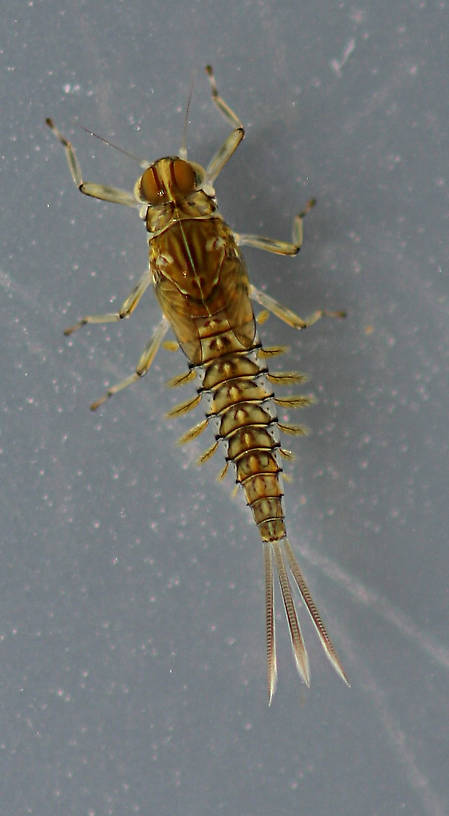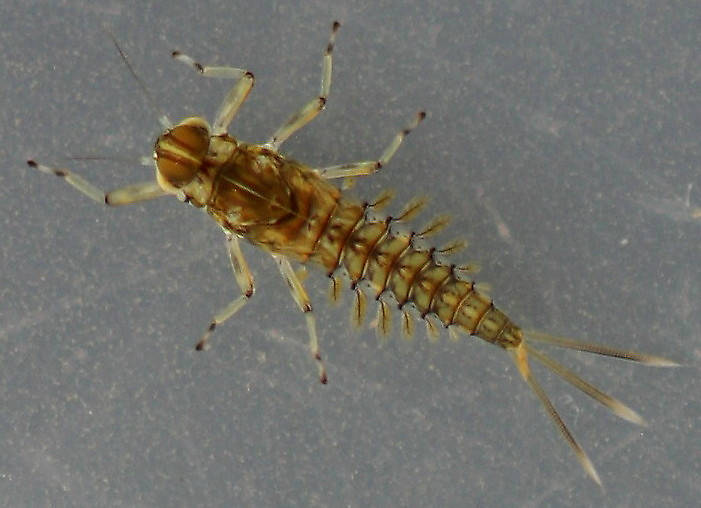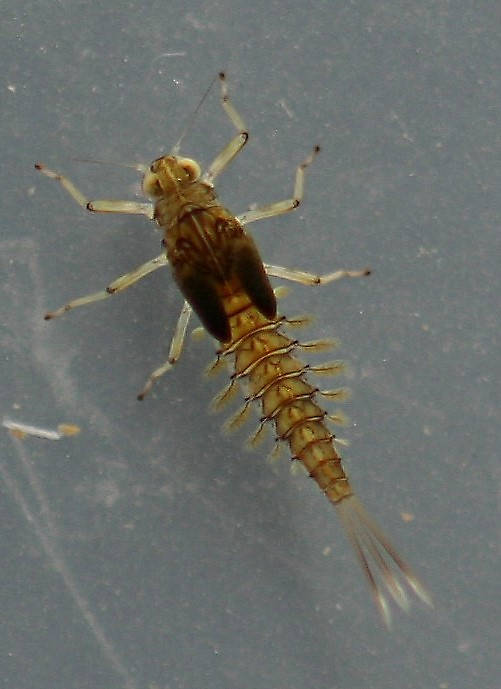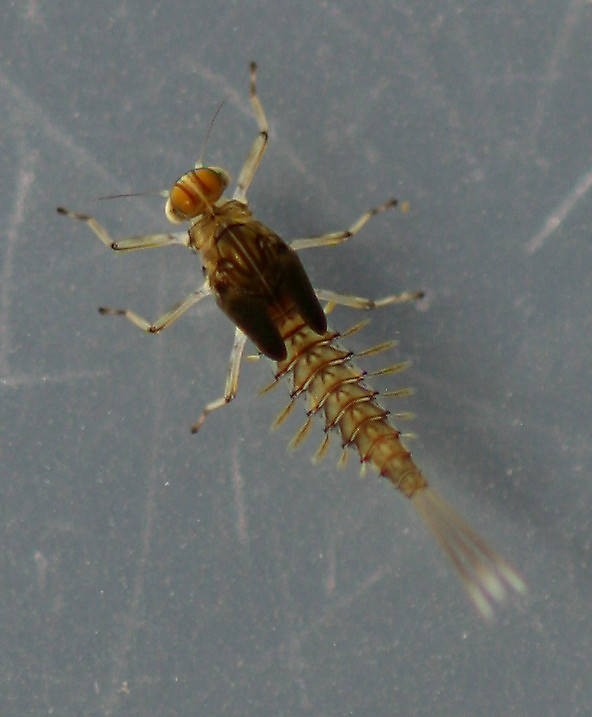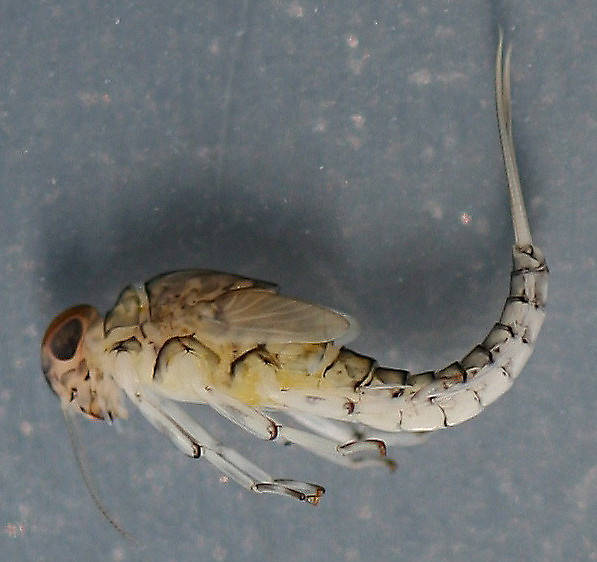Blog & Latest Updates
Fly Fishing Articles
Insects by Common Name


> > Camelobaetidius warreni
| Millcreek | September 13th, 2014, 11:13 pm | |
| Healdsburg, CA Posts: 356 | Camelobaetidius warreni is uncommonly collected in the Russian River. The nymphs were collected in September and are found in areas of moderate current with a bottom of clean small to medium-sized pieces of gravel. Camelobaetidius nymphs are easily separated from other species of Baetidae by their spatulate claws and bowed tarsi. Unfortunately these photos don't show the claws but a representative photo can be seen here: http://www.dfg.ca.gov/abl/images2/camelobaetidius_labeledclaw.png The mature nymphs are 5-6.5 mm in length (excluding cerci). | |
| Entoman | September 14th, 2014, 12:46 am | |
| Northern CA & ID Posts: 2604 | Actually they show up quite well in the last photo, Mark. These are the best photos I've seen of this rare (at least to me) species. Well done! BTW - How did you come up with a species ID? Luke published a paper on these guys back in '05 where he mentioned a few issues that make determination based on suspected diagnostic morphological characters a bit tricky. | |
| "It's not that I find fishing so important, it's just that I find all other endeavors of Man equally unimportant... And not nearly as much fun!" Robert Traver, Anatomy of a Fisherman | ||
| Millcreek | September 14th, 2014, 1:46 am | |
| Healdsburg, CA Posts: 356 | Kurt- Strange little creature, isn't it? I did the ID last year so I had to hunt up the papers I used. I used the keys in McCafferty and Randolph (2000) and Lugo-Ortiz and McCafferty (1995) to ID it to species, then found the paper by Jacobus and McCafferty (2005) which confused me for a while trying to figure out if it was C. maidu or C. warreni. ID eventually came down to the arrangement of setae on the labrum and the specimens I had were consistent with C. warreni. I think it's still a toss of the coin between C. maidu and C. warreni though. Just seems a little too close when you need labral setae to distinguish between the two. The papers I mentioned can be seen at these links: http://www.ephemeroptera-galactica.com/pubs/pub_l/publugoc1995p178.pdf for Lugo-ortiz and McCafferty (1995) http://www.ephemeroptera-galactica.com/pubs/pub_m/pubmccaffertyw2000p259.pdf for McCafferty and Randolph (2000) http://www.ephemeroptera-galactica.com/pubs/pub_j/pubjacobusl2005p153.pdf for Jacobus and McCafferty (2005) | |
| Entoman | September 14th, 2014, 3:57 am | |
| Northern CA & ID Posts: 2604 | Yes, and beautifully marked! They're not mentioned (that I remember), but those thick tails are interesting as well. I've read those papers too. It will be interesting to hear from Luke if anything has changed in the last ten years. | |
| "It's not that I find fishing so important, it's just that I find all other endeavors of Man equally unimportant... And not nearly as much fun!" Robert Traver, Anatomy of a Fisherman | ||
| Millcreek | September 14th, 2014, 11:05 am | |
| Healdsburg, CA Posts: 356 | It will be interesting to hear from Luke if anything has changed in the last ten years. Yeah, I'm hoping Luke will see this and possibly shed a little more light on the issue. I suspect those thick tails have to do with the nymphs swimming ability. These little guys are fast! Haven't seen any other Baetid that can keep up with them. And those claws can grip real well. I usually use a large pipette to suction up specimens I want to photograph (have them inside the sieve in a tub of water). It's usually pretty easy to get other nymphs into the pipette but with these guys I have to get them loose from the sieve by blowing them off with a stream of water from the pipette and catching them before they can reattach. | |
| Konchu | September 14th, 2014, 11:53 am | |
Site Editor IndianaPosts: 505 | Hi, guys. A lot has taken place in the last ten years, with most of the action taking place in South America. There are several things in preparation or in press, too, that I'm aware of. Most of this action from South America has influenced to some extent the way we see our species. Funny this should come up, because tomorrow I'll be working with some species from Central America as well as a couple of those mentioned in this conversation. What particular questions do you have about the species? I appreciate the remarks about collecting them. I'll keep that in mind when I'm out doing fieldwork and give it a try. On another note, how important are these for fishing? | |
| Konchu | September 14th, 2014, 12:00 pm | |
Site Editor IndianaPosts: 505 | Another point. One reason I like this site is because of the good pictures of both living and fresh material. Most of the specimens I look at, especially the most historically important ones, are very old, preserved specimens that have lost their color, at minimum (Most have lost tails and often legs.) and have very few hints of their living grandeur left. Often they are but shadows of their living counterparts. These images help bring them to life. | |
| Millcreek | September 14th, 2014, 12:43 pm | |
| Healdsburg, CA Posts: 356 | What particular questions do you have about the species? Am I actually getting the identification correct with the information I've used or should I just back it off to a generic designation? Are there other accounts I should be using? One reason I like this site is because of the good pictures of both living and fresh material. I started out photographing preserved specimens and wasn't really happy with the results. Dead just looks dead and in many cases the colors fade quickly. The Camelobaetidius above is a good example. Color fades almost immediately after putting them in alcohol. I still photograph preserved specimens occasionally to show a particular feature or because live specimens just aren't available. On another note, how important are these for fishing? Probably not much, at least in this area. It's not common as a nymph and I've never collected adults. But you never know, other areas may have more abundant populations. | |
| Entoman | September 14th, 2014, 12:54 pm | |
| Northern CA & ID Posts: 2604 | Hi Luke, I'm not aware of any significance to angling, but who knows what the future may bring. Our hatches are quite different from what they were 25, 50 and a hundred years ago. Populations wax and wain anyway but ecological changes wrought by humans and natural events have had a tremendous impact. As for questions, we were pondering the reliability of the characters used to determine species. In your paper you cautioned against counting on them too much and mentioned that more DNA work needed to be done. Is that still the case or can claw denticles and labrum setae counts/location be used for identification. | |
| "It's not that I find fishing so important, it's just that I find all other endeavors of Man equally unimportant... And not nearly as much fun!" Robert Traver, Anatomy of a Fisherman | ||
| Konchu | September 14th, 2014, 1:33 pm | |
Site Editor IndianaPosts: 505 | More specimens and more data almost always are a good thing as far as understanding who is who. But for now, I think the key of McCafferty & Randolph (2000) can be used to identify the North American species, with only a modification to Couplet 5, based on work by Jacobus & McCafferty (2005). 5. Labrum with intermediary setae and 2-4 sublateral setae on each side (J&McC 2005:Fig. 3) = warreni. 5. Labrum with no intermediary setae and 5-9 sublateral setae on each side (J&McC 2005:Fig.1) = maidu. Jacobus LM; McCafferty WP. 2005. A new species and new synonym in Camelobaetidius Demoulin (Ephemeroptera: Baetidae). Journal of the Kansas Entomological Society 78:153-157. McCafferty WP; Randolph RP. 2000. Further contributions to the spatulate clawed Baetidae (Ephemeroptera). Entomological News 111(4):259-264. | |
| Millcreek | September 14th, 2014, 1:49 pm | |
| Healdsburg, CA Posts: 356 | Thanks Luke, With that info I'll stick with C. warreni. | |
| Oldredbarn | September 15th, 2014, 11:12 am | |
| Novi, MI Posts: 2608 | Great photos Mark...You do a wonderful job. Like I've told you before, I'd like it if you lived in Grayling though. :) Great discussion. Spence | |
| "Even when my best efforts fail it's a satisfying challenge, and that, after all, is the essence of fly fishing." -Chauncy Lively "Envy not the man who lives beside the river, but the man the river flows through." Joseph T Heywood | ||
| Millcreek | September 15th, 2014, 2:42 pm | |
| Healdsburg, CA Posts: 356 | Great photos Mark...You do a wonderful job. Like I've told you before, I'd like it if you lived in Grayling though. :) Thanks Spence, still not planning on moving to Grayling, though.:) Great discussion. That's one the things I like about this forum. There are times when I get wrapped up in trying to figure out a species or just some aspect of it and my brain ends up going in circles with no way out. One of the joys of being obsessive, I guess:). The discussions here are a good way to get a different perspective and good information. | |
| Oldredbarn | September 15th, 2014, 9:24 pm | |
| Novi, MI Posts: 2608 | That's one the things I like about this forum. There are times when I get wrapped up in trying to figure out a species or just some aspect of it and my brain ends up going in circles with no way out. One of the joys of being obsessive, I guess:). The discussions here are a good way to get a different perspective and good information. Very well put. | |
| "Even when my best efforts fail it's a satisfying challenge, and that, after all, is the essence of fly fishing." -Chauncy Lively "Envy not the man who lives beside the river, but the man the river flows through." Joseph T Heywood | ||
| PaulRoberts | September 15th, 2014, 10:20 pm | |
| Colorado Posts: 1776 | One of the many things I like about this forum is that there are those here that bother with the important stuff! Thanks for sharing the cool stuff with us all. | |
| Millcreek | September 16th, 2014, 2:38 pm | |
| Healdsburg, CA Posts: 356 | Paul - Glad you enjoyed the ride. Just a little additional info on these guys, an older (1968) paper by Traver and Edmunds: "A revision of the Baetidae with spatulate-clawed nymphs (Ephemeroptera)". http://www.ephemeroptera-galactica.com/pubs/pub_t/pubtraverj1968p629.pdf Camelobaetidius warreni is described under Dactylobaetis warreni and D. cepheus, both older synonyms for C. warreni. | |
Quick Reply
You have to be logged in to post on the forum. It's this easy:
Related Discussions
| Title | Replies | Last Reply |
| Re: Fallceon spp. (15 more) In the Identify This! Board by Millcreek | 4 | Nov 21, 2014 by Millcreek |
| Re: Paraleptophebia In the Photography Board by Crepuscular | 1 | Feb 23, 2013 by Entoman |
| More Baetis nymphs (2 more) In the Identify This! Board by Millcreek | 0 | |
| Re: Isoperla nymphs (2 more) In the Photography Board by Millcreek | 6 | Sep 4, 2014 by Oldredbarn |
| Re: Baetis spp. In the Identify This! Board by Millcreek | 16 | Oct 8, 2014 by Millcreek |
| Acentrella insignificans nymphs (1 more) In the Photography Board by Millcreek | 0 | |
| Re: Heptagenia? In Leucrocuta hebe Mayfly Nymph by GONZO | 2 | Jul 19, 2011 by GONZO |
| Re: Ameletus spp. (4 more) In the Identify This! Board by Millcreek | 12 | Jul 25, 2014 by Crepuscular |
| Re: Anyone recognize this Baetid nymph? In Male Baetidae Mayfly Nymph by Troutnut | 24 | Jul 21, 2011 by Entoman |
| Re: Stonefly identification In the Identify This! Board by Uppersac | 20 | Jul 22, 2015 by Millcreek |
Troutnut.com is copyright © 2004-2024 Jason
Neuswanger (email Jason). See my FAQ for information about use of my images.
 privacy policy
privacy policy

